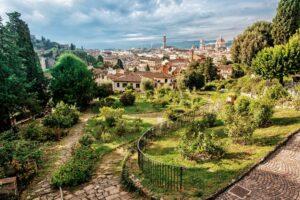Fodor's Expert Review Spedale degli Innocenti
The building built by Brunelleschi in 1419 to serve as an orphanage takes the historical prize as the very first Renaissance building. Brunelleschi designed its portico with his usual rigor, constructing it from the two shapes he considered mathematically (and therefore philosophically and aesthetically) perfect: the square and the circle. Below the level of the arches, the portico encloses a row of perfect cubes; above the level of the arches, the portico encloses a row of intersecting hemispheres. The entire geometric scheme is articulated with Corinthian columns, capitals, and arches borrowed directly from antiquity.
At the time he designed the portico, Brunelleschi was also designing the interior of San Lorenzo, using the same basic ideas. But because the portico was finished before San Lorenzo, the Spedale degli Innocenti can claim the honor of ushering in Renaissance architecture. The 10 ceramic medallions depicting swaddled infants that decorate the portico are by Andrea... READ MORE
The building built by Brunelleschi in 1419 to serve as an orphanage takes the historical prize as the very first Renaissance building. Brunelleschi designed its portico with his usual rigor, constructing it from the two shapes he considered mathematically (and therefore philosophically and aesthetically) perfect: the square and the circle. Below the level of the arches, the portico encloses a row of perfect cubes; above the level of the arches, the portico encloses a row of intersecting hemispheres. The entire geometric scheme is articulated with Corinthian columns, capitals, and arches borrowed directly from antiquity.
At the time he designed the portico, Brunelleschi was also designing the interior of San Lorenzo, using the same basic ideas. But because the portico was finished before San Lorenzo, the Spedale degli Innocenti can claim the honor of ushering in Renaissance architecture. The 10 ceramic medallions depicting swaddled infants that decorate the portico are by Andrea della Robbia (1435–1525/28), done in about 1487.
Within the building is the small Museo degli Innocenti. Although most of the objects are minor works by major artists, they're still worth a look. Of note is Domenico Ghirlandaio's (1449–94) Adorazione dei Magi (Adoration of the Magi), executed in 1488.
READ LESS







